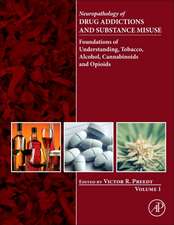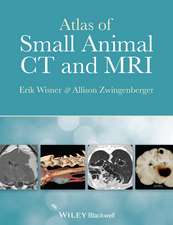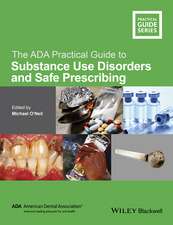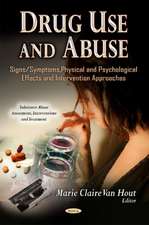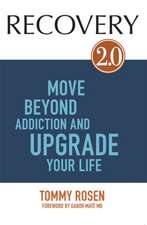Drug Addiction: From Basic Research to Therapy
Editat de Rao S. Rapaka, Wolfgang Sadéeen Limba Engleză Paperback – 24 noi 2010
| Toate formatele și edițiile | Preț | Express |
|---|---|---|
| Paperback (1) | 1627.29 lei 43-57 zile | |
| Springer – 24 noi 2010 | 1627.29 lei 43-57 zile | |
| Hardback (1) | 1324.07 lei 38-44 zile | |
| Springer – 6 iul 2008 | 1324.07 lei 38-44 zile |
Preț: 1627.29 lei
Preț vechi: 1712.94 lei
-5% Nou
Puncte Express: 2441
Preț estimativ în valută:
311.37€ • 325.98$ • 257.65£
311.37€ • 325.98$ • 257.65£
Carte tipărită la comandă
Livrare economică 07-21 aprilie
Preluare comenzi: 021 569.72.76
Specificații
ISBN-13: 9781441926326
ISBN-10: 1441926321
Pagini: 816
Ilustrații: XXIII, 782 p. 197 illus., 1 illus. in color.
Dimensiuni: 155 x 235 x 43 mm
Greutate: 1.12 kg
Ediția:Softcover reprint of hardcover 1st ed. 2008
Editura: Springer
Colecția Springer
Locul publicării:New York, NY, United States
ISBN-10: 1441926321
Pagini: 816
Ilustrații: XXIII, 782 p. 197 illus., 1 illus. in color.
Dimensiuni: 155 x 235 x 43 mm
Greutate: 1.12 kg
Ediția:Softcover reprint of hardcover 1st ed. 2008
Editura: Springer
Colecția Springer
Locul publicării:New York, NY, United States
Public țintă
ResearchDescriere
Drug Addiction: From Basic Research to Therapy provides a comprehensive overview of physiological, biochemical, and genetic pathways underlying drug addiction, and resultant efforts to develop novel treatment strategies dealing with drug addiction and other CNS disorders where the neurophysiological processes overlap, such as treatment of pain. Based on the AAPS-NIDA Frontiers in Science Symposium “Drug Addiction: From Basic Research to Therapies,” this volume, representing focuses on the translation of fundamental addiction research to a variety of treatments, bringing together scientists with widely ranging expertise in synthetic and computational chemistry, molecular biology, genetics, and neuroscience with researchers in drug discovery and development, drug targeting, and quantitative therapeutics.
Cuprins
I. General Topics 1. Per Svenning, Angus C. Nairn and Paul Greengard DARPP-32 mediates the actions of multiple drugs of abuse 2. Young-Won Chin, Marcy J. Balunas, Hee Byung Chai, and A. Douglas Kinghorn Drug discovery from natural sources 3. Patricia H. Reggio Computational methods in drug design: Modeling G protein-coupled receptor monomers, dimers and oligomers 4. Joni L Rutter Symbiotic relationship of pharmacogenetics and drugs of abuse 5. Eric Peterson, S. Michael Owens, and Ralph L. Henry Monoclonal antibody form and function: Manufacturing the right antibodies for treating drug abuse 6. MJ Kuhar, JN Jaworski, GW Hubert, KB Philpot and G. Dominguez CART peptides play a role in drug abuse and potential therapeutic agents 7. Madhavan P.N. Nair, Jessica L. Reynolds, Supriya D. Mahajan, Stanley A.Schwartz, Ravikumar Aalinkeel, Bindukumar B. Don Sykes RNAi directed inhibition of DC-SIGN in dendritic cells. Prospects for HIV-1 therapy 8. Martin W. Adler, Ellen B. Geller, Xiaohong Chen, and Thomas J. Rogers Viewing chemokines as a third major system in the brain 9. Andrea Piserchio, Mark Spaller, and Dale F. Mierke Targeting the PDZ domains of molecular scaffolds of transmembrane ion channels 10. Lorise C. Gahring and Scott W. Rogers Neuronal nicotinic acetylcholine receptor expression and function on non-neuronal cells II. Transporters & stimulants & HALLUCINOGENS 1. Evan L. Riddle, Annette E. Fleckenstein and Glen R. Hanson Role of monamine transporters in mediating psychostimulant effects 2. F. Ivy Carroll, James L. Howard, Leonard L. Howell, Barbara S. Fox, and Michael J. Kuhar Development of the dopamine transporter selective RTI-336as a pharmacotherapy for cocaine abuse 3. Kellie J. White, Crystal C. Walline, and Eric L. Barker Serotonin transporters: Implications for antidepressant drug development 4. Tobin J. Dickerson and Kim D. Janda Recent advances for the treatment of cocaine abuse: Central nervous system immunopharmacotherapy 5. Thomas E. Prisinzano, Kevin Tidgewell and Wayne W. Harding Kappa opioids as potential treatments for stimulant dependence 6. Lankupalle D. Jayanthi and Sammanda Ramamoorthy Regulation of monoamine transporters: Molecular targets of psychostimulants and therapeutic antidepressants 7. Harel Weinstein Hallucinogen actions on 5-HT receptors reveal distinct mechanisms of activation and signaling by G protein-coupled receptors 8. Christopher K. Surratt, Okechukwu T. Ukairo and Suneetha Ramanujapuram Recognition of psychostimulants, antidepressants and other inhibitors of synaptic neurotransmitter uptake by the plasma membrane monoamine transporters 9. Richard B. Rothman, Bruce E Blough, and Michael H Baumann Dual DA/5-HT releasers as potential medications for stimulant and alcohol addictions 10. Anita H. Lewin Receptors of mammalian trace amines III. Drug Design: Nicotine, opioids and related ligands 1. Jeffrey R. Deschamps The role of crystallography in drug design 2. Peter W. Schiller Opioid peptide-derived analgesics 3. Subramaniam Ananthan Opioid ligands with mixed mu/delta receptor interactions: An emerging approach to novel analgesics 4. Nurulain Zaveri, Faming Jiang, Cris Olsen, Wilma Polgar and Lawrence Toll Small molecule agonists and antagonists of the opioid-receptor like receptor (ORL1, NOP): Ligand-based analysis of structural factors influ
Recenzii
From the reviews:
"This book grew out of a symposium entitled ‘Frontiers in Science: Drug Addiction–From Basic Research to Therapies’ held at the end of 2004. … The book is composed of 44 chapters, all concerned with basic science research relevant to drug dependence. … even for basic scientists this book is best approached as one where at most a few chapters may be of interest to any researcher … in drug addiction." (Jason White, Drug And Alcohol Review, Vol. 28, July, 2009)
"This book grew out of a symposium entitled ‘Frontiers in Science: Drug Addiction–From Basic Research to Therapies’ held at the end of 2004. … The book is composed of 44 chapters, all concerned with basic science research relevant to drug dependence. … even for basic scientists this book is best approached as one where at most a few chapters may be of interest to any researcher … in drug addiction." (Jason White, Drug And Alcohol Review, Vol. 28, July, 2009)
Textul de pe ultima copertă
Drug Addiction: From Basic Research to Therapy provides a comprehensive overview of physiological, biochemical, genetic and behavioral pathways underlying drug addiction. Focusing on fundamental neurophysiological processes that overlap between drug addiction and other CNS disorders, this volume covers the translation of basic research into novel therapies, not only of drug addiction but a spectrum of related CNS disorders, including pain. Chapters are written by leading scientists with widely ranging expertise in synthetic and computational chemistry, molecular biology, genetics, neurosciences, drug discovery and development, drug targeting, and quantitative therapeutics, providing an unprecedented overview of a complex field of high societal signficance.
Caracteristici
Provides a comprehensive overview of physiological, biochemical, and genetic pathways underlying drug addiction, and resultant efforts to develop novel treatment strategies dealing with drug addiction and other CNS disorders where the neurophysiological processes overlap, such as treatment of pain
Focuses on the translation of fundamental addiction research to a variety of treatments, bringing together scientists with widely ranging expertise in synthetic and computational chemistry, molecular biology, genetics, and neuroscience with researchers in drug discovery and development, drug targeting, and quantitative therapeutics
Focuses on the translation of fundamental addiction research to a variety of treatments, bringing together scientists with widely ranging expertise in synthetic and computational chemistry, molecular biology, genetics, and neuroscience with researchers in drug discovery and development, drug targeting, and quantitative therapeutics

